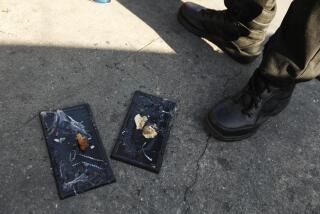Man’s battle vs. the rat goes high-tech
- Share via
It’s hard not to admire the common house mouse, Mus musculus. Upon setting up a new home, it neatly separates kitchen, bedroom and toilet areas. It has evolved to make its own vitamin C, and it’s sensible enough to fear not only black lights (possibly because a mouse’s urine has a fluorescent glow) but also rats (Musicide is common).
Males are bucks. Females are does. A baby mouse is called a pinky.
FOR THE RECORD:
Mousetrap design: A Jan. 6 article on the history of mousetrap design said the Kness Ketch-All trap was invented in 1924, at the start of the Great Depression. The device was invented before the Depression, which didn’t start until 1929. —
If you tickle a mouse, it laughs.
It’s all so cute, but there is a reason why the word “mouse” comes from mus, a Sanskrit word for “thief.” The creature may have been worshiped in ancient Greece, kept as a pet in China and eaten as a remedy for stomachache by the pharaohs, but today most of us just want it gone -- dead, or at least out of our homes (no small feat when it can squeeze through cracks just a quarter-inch wide).
Civilizations dating to ancient Italy have tried to keep out the mouse. The Romans put strawberry oil in candles because the animal doesn’t like the smell. By the 1800s, killing rodents had nearly become a science as Victorian inventors tinkered with hand-built devices for impaling, decapitating, crushing, suffocating or drowning the vermin. In 1897, the Little Nipper -- a cheaply fabricated spring-loaded trap that broke backbones and crushed skulls in three-hundredths of a second -- set a precedent in modern design. And the quest to build a better mousetrap has continued ever since.
In 1924, at the start of the Great Depression, a schoolhouse janitor in Alba, Iowa, named Austin Enos Kness saw mice getting into kids’ lunches kept in the cloakroom. He took a square oil can, a tobacco tin and a spring from a curtain rod, and built the first modern metal box trap, catching five four-legged thieves on the first night. Eighty-five years later, the Kness Ketch-All is still popular, used from Dubai to Disney World. The windup mechanical trap uses no bait and does not kill the victims but rather “spanks” them into a holding area.
“It works off of curiosity,” says Kathy Kness Wauson, the inventor’s granddaughter and president of Kness Mfg. Co., which is still based in Alba. “It sends the mouse down a tunnel that leads to a trap door. And that flips him over.”
Kness also sells a more sinister-sounding “drowning attachment” as well as traps with glue-tape floors that are marketed as “easier, faster and more sanitary.”
Such designs may be newer, but they’re also crueler, according to People for the Ethical Treatment of Animals. Last year the group launched a campaign to persuade Lowe’s home improvement stores to stop selling glue traps. Volunteers dressed in mouse suits went into stores to enact the fur-ripping, nose-sticking, starvation and suffocation inherent in the design. Mice that don’t die quickly sometimes try to gnaw off their limbs to escape. The PETA performances were done street-theater-style, a miniature “The Passion of the Christ” in Aisle 5. In Toledo, Ohio, a young woman in a mouse suit threw herself down on a glued Lowe’s floor in November and writhed in agony for a half-hour before the police carried her away.
Glue traps are inexpensive, but PETA says they can become a source for disease because the mice may live for hours, urinating, defecating and otherwise leaving behind a potential hantavirus hot zone.
“The CDC [Centers for Disease Control] has issued warnings about the traps because picking up the rodents in the traps can lead to diseases,” says Kate Brindoe, a PETA campaigner. “Also non-target animals like birds will become victims of the traps. They are cheaper, but the animals suffer in the long run.”
That explains the development of alternatives such as RADAR, the Rodent Activated Detection and Riddance unit built by the British pest control company Rentokil. This baited trap is shaped like a small covered tunnel; a pressure-sensitive floor and infrared sensors trigger an airtight door to shut and carbon dioxide gas to be released. At the end of the execution, the trap sends an e-mail notification of a successful kill.
This method is considered by some animal advocates to be the least painful and thus the most humane, leading PETA to award Rentokil’s chief biologist with a Person of the Year Award in 2005. (The trap is not yet available in California.)
Victor, one of the biggest names in old-fashioned snap traps, recently released the Multi-Kill Electronic Mouse Trap, which looks like some old-school black metal lunch pail. Tiny mouse stairs lead to pressure-sensitive floor panels that deliver a fatal shock when activated. The floor then rotates, dropping the body into a holding chamber before the device resets itself. Price: $99.99.
Ultra-sonic mouse repellents on the market purport to ward off vermin with high-frequency sound waves. But Keith Willingham, vice president of technical services for Anaheim-based Western Exterminator Co., says such products don’t really work. He says the most reliable choice is the oldest: a snap trap based on the Little Nipper design.
“The vast majority of the time the snap trap kills them instantly,” he says.
Or you could get a cat.


